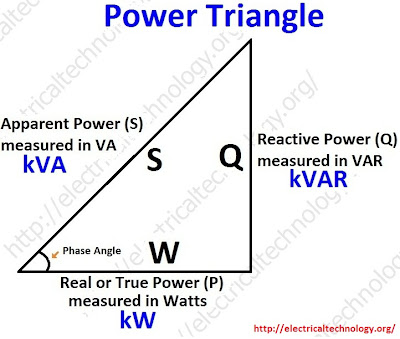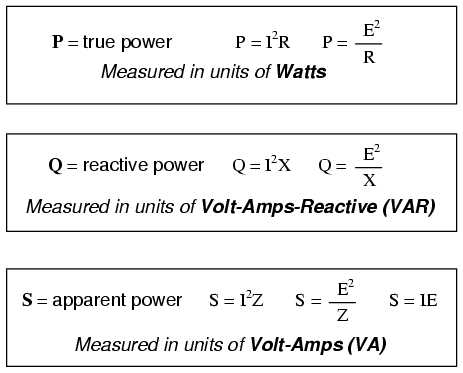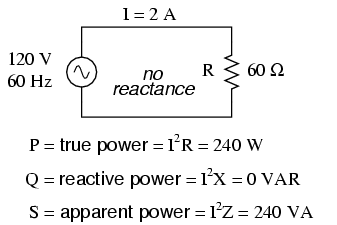Register now or log in to join your professional community.

Capacitor absorbs the reactive power and dissipates in the form of electric or electrostatic filed
∴ These all quantities trigonometrically related to each other as shown in below figure. Click image to enlarge For more Clearance and explanation., i used Lays Chips and Beer Analogy for Real or True Power, Reactive Power , Apparent power and power factor Lays Chips Analogy of Real or True Power, Reactive Power, Apparent power & power factor Click image to enlarge
For more Clearance and explanation., i used Lays Chips and Beer Analogy for Real or True Power, Reactive Power , Apparent power and power factor Lays Chips Analogy of Real or True Power, Reactive Power, Apparent power & power factor Click image to enlarge

Beer Analogy of Active or True power, Reactive power, Apparent Power and Power factor.


For the relationship between active power and reactive power, basing on the common power factor angle of a system represented by the symbol "ϴ" common to both power we can say that their relationship can be referred to the following formulas: (Same on single phase or three phase)
Active power (Resistive) P = Volts (V) x Current (I) x Cosine ϴ
Reactive power (Inductive or Capacitive) P = Volts (V) x Current (I) x Sine ϴ
However we cannot change reactive power to active power because they are of different criteria in power (based on Power Triangle). Active power is based on true and resistive load quantities while Reactive power is based on inductive or capacitive load quantities in the electrical systems.

We know that reactive loads such as inductors and capacitors dissipate zero power, yet the fact that they drop voltage and draw current gives the deceptive impression that they actually do dissipate power. This “phantom power” is called reactive power, and it is measured in a unit called Volt-Amps-Reactive (VAR), rather than watts. The mathematical symbol for reactive power is (unfortunately) the capital letter Q. The actual amount of power being used, or dissipated, in a circuit is called true power, and it is measured in watts (symbolized by the capital letter P, as always). The combination of reactive power and true power is called apparent power, and it is the product of a circuit's voltage and current, without reference to phase angle. Apparent power is measured in the unit of Volt-Amps (VA) and is symbolized by the capital letter S.
As a rule, true power is a function of a circuit's dissipative elements, usually resistances (R). Reactive power is a function of a circuit's reactance (X). Apparent power is a function of a circuit's total impedance (Z). Since we're dealing with scalar quantities for power calculation, any complex starting quantities such as voltage, current, and impedance must be represented by their polar magnitudes, not by real or imaginary rectangular components. For instance, if I'm calculating true power from current and resistance, I must use the polar magnitude for current, and not merely the “real” or “imaginary” portion of the current. If I'm calculating apparent power from voltage and impedance, both of these formerly complex quantities must be reduced to their polar magnitudes for the scalar arithmetic.
There are several power equations relating the three types of power to resistance, reactance, and impedance (all using scalar quantities):

Please note that there are two equations each for the calculation of true and reactive power. There are three equations available for the calculation of apparent power, P=IE being useful only for that purpose. Examine the following circuits and see how these three types of power interrelate for: a purely resistive load in Figure belw, a purely reactive load in Figure belw, and a resistive/reactive load in Figure belw.
Resistive load only:

True power, reactive power, and apparent power for a purely resistive load.
Reactive load only:

True power, reactive power, and apparent power for a purely reactive load.
Resistive/reactive load:

True power, reactive power, and apparent power for a resistive/reactive load.
These three types of power -- true, reactive, and apparent -- relate to one another in trigonometric form. We call this the power triangle: (Figure belw).

Power triangle relating appearant power to true power and reactive power.
Using the laws of trigonometry, we can solve for the length of any side (amount of any type of power), given the lengths of the other two sides, or the length of one side and an angle.


aternative words for real power - actual power/true power/ active power
reactive power also known as use less power/ watt less power
The power that continuously bounceback and forth between source and load is referred as reactive power
The power between source and load is real power
we cannot convert ctive power to reactive power



